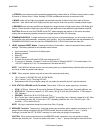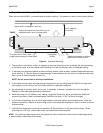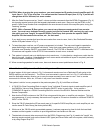
Page 14 Model PA635
© 2001 Xantech Corporation.
CAUTION: When changing the group numbers, you must connect an IR receiver to each amplifier pair's IR
input (item 11, Fig. 3) one at a time. You cannot use the Common IR Input (item 15, Fig. 3) as this will
change them all to a different, but same number.
7. After the Code Groups are set up, "teach" volume and other commands from the RC68+ Programmer (Fig. 4)
into learning remote controls (and the keypads) dedicated to each room. Be sure to set the RC68+ to the
specific Code Group Number that corresponds to the ones chosen for each of the amplifier pairs, during this
"teaching" process.
NOTE: With a Common IR Bus system, you cannot carry the same remote control from room-to-
room. You must use a dedicated learning remote (such as the Xantech URC versions) for each room
into which you have "taught" the specific RC68+ Code Group that operates the specific PA635
Amplifier Pair that controls the volume, etc., for that room!
If you wish to carry remotes that have the same codes from room-to-room, that is, Non-Dedicated Remotes,
use the IR System shown in Fig. 9.
8. To keep the system cost low, no AC power management is included. The user would need to operate the
power switching for each component individually, using front panel power switches, or IR, as appropriate.
Individual room Standby ON/OFF is provided, however. The STATUS of Standby ON/OFF is indicated at the
IR receivers and keypads via the STATUS line connection to each room, as shown.
9. This system is primarily set up to distribute music to each room. A video feed to a single room could also be
done at low cost. However, video distribution to all rooms would add additional layers of complexity and cost
that would best be handled by a ZPR68-10.
10. When connecting speakers for each room, be sure to observe correct polarities as shown in Fig. 6.
A Basic Dedicated IR System - Non-Dedicated Keypads and Remotes.
A typical system of this type is shown in Fig. 9, where each remote room has a Dedicated IR path going to the
PA635 amplifier pair that controls it. The IR bus is not connected in common as it is in Fig. 8. It eliminates the
need for dedicated remotes, allowing you to carry the same remote(s) from room-to-room - that is, remote
commands for Volume, Mute, etc., will work in any room from the same remote.
This system is similar in many respects to the previous system (Fig. 8), but differs as follows:
1. A 796-20 Six Zone Connecting Block is used to "zone" individual IR control signals to each amplifier pair of
the PA635 for Volume, Mute, Balance and Standby ON/OFF action in each room. It also carries a
"COMMON" IR signal to a 789-44 Connecting Block for control of the RS41AV Remote Switcher and the
Source Components.
2. Note that the ZONE numbers on the 796-20 do not agree with the room or amplifier pair numbers. This is of
no consequence; it is only necessary that each room's keypad or IR receiver connects to a different ZONE IR
INPUT on the 796-20.
3. Since the 796-20 channels the IR from each room to it's specific PA635 amplifier pair, each amplifier pair can
use the same IR Code Group (the factory default B0).
4. While use of the 796-20 entails some added expense, it reduces programming time for both the hand-held
remotes and the keypads, in addition to providing additional convenience to the user.
5. The desired volume and other commands from the RC68+ Programmer (see Fig. 4) need to be "taught" into
learning remote controls (such as the Xantech URC types) and Smart Pads used in the system, either directly
or by using Dragon Drop IR™.


















